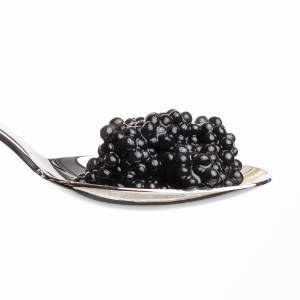Miscellaneous Category

Includes thickeners and food wrappers
herring roe
The Japanese traditionally serve this on New Year's Day. It has an interesting texture, but it's not very flavorful.
Learn moreimperial caviar
In recent years, over-fishing in the Caspian Sea has greatly depleted sturgeon populations.Please consider using caviar and roe from more abundant species until the Caspian Sea sturgeon populations can recover. For substitutions for caviar in general, click here.
Learn moreInstant Clearjel
This is a modified cornstarch that professional bakers sometimes use to thicken pie fillings. It has several advantages over ordinary cornstarch. Instant ClearJel® thickens without cooking, works well with acidic ingredients, tolerates high temperatures, is freezer-stable, and doesn't cause pie fillings to weep" during storage. Don't use Instant ClearJel® for canning--it tends to break down.
Learn moreInstant flour
You can mix this granular all-purpose flour into liquids without getting many lumps, so it's perfect for making gravies and batters. It's also good for breading fish. Wondra flour and Shake & Blend are popular brands.
Learn moreinstant tapioca
These small, starchy granules are used to make tapioca pudding and to thicken pie fillings. The grains don't dissolve completely when cooked, so puddings and pies thickened with them end up studded with tiny gelatinous balls. If you don't mind the balls, you can also use instant tapioca to thicken soups, gravies, and stews. If the balls are a problem, just pulverize the instant tapioca in a coffee grinder or blender, or buy tapioca starch, which is already finely ground. Instant tapioca tolerates prolonged cooking and freezing, and gives the fillings an attractive glossy sheen. To use it in a pie filling, mix it with the other ingredients, then let it sit for at least five minutes so that the tapioca can absorb some of the liquid. Don't confuse instant tapioca with regular tapioca, which has larger beads, or with the even larger tapioca pearls sold in Asian markets. Minute® tapioca is a well-known brand.
Learn moreJamaica
Jamaica is another name for the hibiscus flower. Tea made from Jamaica flowers is red, tart and is high in vitamin C. Substitutes: Red Zinger tea
Learn morekampyo
Japanese cooks soak these gourd strips in water, then use them to tie sushi or other food packets. They're also sometimes cooked and used as an ingredient in sushi. Look for them in Japanese markets.
Learn morekudzu powder
This thickener is made from the tuber of the kudzu, the obnoxious vine that was imported from Japan a number of years ago and is now growing out of control all over the South. It's very expensive, and the main reason to buy it is for its reputed medicinal benefits. It comes in small chunks. To thicken a liquid, crush the chunks into a powder, mix them with an equal amount of cold water, then stir the mixture into the hot liquid and simmer for a few minutes until the sauce is thickened. Look for kudzu in health food stores.
Learn morelecithin
Derived from soy beans or egg yolks, nutrient-rich lecithin is a wonder ingredient. It's used in cooking as an emulsifier, preservative, lubricant, and moisturizer. It's a healthful substitute for fat in baked goods, adding moisture and improving texture. Bakers use it as a dough enhancer because it helps give yeast breads more of a rise. It comes either granulated or as a liquid.
Learn morelievito di vaniglia
This is an Italian yeast with a delicate vanilla flavor. Look for this in Italian markets.
Learn morelotus leaves
These leaves open up like butterfly wings, each about two feet high. They're often wrapped around rice and other fillings, to which they impart an earthy aroma when the bundles are steamed. The leaves are available either fresh or, more commonly, dried in Asian markets. Soak them for at least an hour in warm water before using, and keep fresh leaves in a cool, dry place or else freeze them.
Learn morelotus root
Slices of the lotus root have a beautiful pattern. The fresh version is available sporadically; if not, the canned version is almost as good. Rinse and drain before using. Look for it in Asian markets.
Learn moremaguey leaves
These leaves have been used to wrap meat for flavor and to tenderize while cooking.
Learn moremalt powder
You can make malt powder by allowing whole grains to sprout briefly, drying them, and then grinding them into a powder. Commercial malt powders are usually made with barley, and they're used extensively by commercial bakers. There are two main types of malt powder: diastatic and non-diastatic. Diastatic malt contains active enzymes which help break starch down into sugar. The extra sugar feeds the yeast in the dough, helping the bread to rise, and also gives the bread a browner crust. It's often used to make crusty breads. Non-diastatic malt doesn't have active enzymes, but it gives baked goods better flavor and a shinier, browner crust. It's used in everything from bagels to croissants to breakfast cereals. Don't confuse malt powder with malted milk powder, which also contains powdered milk and wheat flour and is used to make beverages. Look for malt powder in health food stores or baking supply stores.
Learn moremastic gum
It's usually sold in the form of small crystals, which you'll need to grind into a powder. Look for it in Middle Eastern markets.
Learn moremeat tenderizer
Various ingredients can be used to tenderize meat. These include vinegar, baking soda, beer or commercial products. Meat can also be tenderized using a mallet.
Learn moreossetra caviar
In recent years, over-fishing in the Caspian Sea has greatly depleted sturgeon populations. Please consider using caviar and roe from more abundant species until the Caspian Sea sturgeon populations can recover. Ossetra caviar is brown and more strongly flavored than beluga caviar. Don't confuse ordinary ossetra with the rare and expensive golden ossetra = imperial caviar. If substituting an inferior caviar, consider perking it up with a splash of fresh lemon juice. For substitutions for caviar in general, click here.
Learn morepaddlefish roe
Paddlefish swim in Southern rivers and they're relatives of sturgeons--the fish that produce the world's most expensive and exquisite caviars. Paddlefish roe is very similar to sevruga caviar, only it's cheaper. Since Caspian Sea sturgeon are rapidly becoming depleted from over-fishing, many people are turning to paddlefish roe as a substitute for caviar.
Learn moreparchment paper
This is a heavy, silicone-coated paper that's used to line pans so that candies and baked goods won't stick. It's an expensive alternative to waxed paper, but it's less sticky, so it's a good choice if you're making gooey items. Parchment paper is also wrapped around foods to be cooked en papillote, or formed into cones for cake decorating. Specialty cooking stores and larger supermarkets often carry rolls or sheets of it. Paper grocery bags are sometimes recommended as a substitute for parchment paper, but it's not advisable to use them. Grocery bags will ignite at 450 degrees, and that they may have been treated with unsafe chemicals.
Learn morepectin
In order to make preserves like jams and jellies, you normally cook together fruit, acid, sugar, and pectin, a substance found in certain fruits that gels when heated. Some fruits -- like quinces, gooseberries, tart apples, and sour plums -- contain enough natural pectin that they'll thicken all by themselves into preserves. Others, like cherries and some berries, need an extra boost to firm up. Jam recipes for pectin-deficient fruit normally call for liquid or powdered pectin, which you can find among the baking supplies in most supermarkets. The recipes usually specify what brand of pectin to use, and it's not a good idea to substitute one brand for another, since they have different formulas. Some brands (like Sure Jell and Certo) need acid and sugar to set, some (like Sure Jell for Low Sugar Recipes) need acid and just a little sugar to set, some (like Pomona's Universal Pectin® or Mrs. Wages Lite Home Jell Fruit Pectin®) don't need any sugar to set. Liquid pectin contains sulfite, which can cause an allergic reaction in people with sulfite sensitivites, but powdered pectin does not.
Learn moreplastic wrap
Plastic wrap is terrific for covering foods to be stored in the refrigerator or cooked in the microwave. It clings especially well to glass, ceramic, and china dishes. You can also use it to wrap foods for short-term freezer storage, though you should use aluminum foil if you're storing something in the freezer for a long time since foil is better at preventing moisture loss.
Learn morepollock roe
Asian markets sell this inexpensive roe in wooden boxes. It's often baked and served on rice.
Learn morepotash
This is sometimes used to make gingerbread and honey cake. Look for it in German markets.
Learn morepotassium bicarbonate
This is used as a substitute for baking soda by people on sodium-restricted diets. Look for it in pharmacies.
Learn morepotato starch
This gluten-free starch is used to thicken soups and gravies. Its main advantage over other starch thickeners is that it's a permitted ingredient for Passover, unlike cornstarch and other grain-based foods. Liquids thickened with potato starch should never be boiled. Supermarkets often stock it among the Kosher products.
Learn morepotsticker wrappers
These small, thick wrappers are stuffed with meat fillings, and then pan-fried and steamed. While assembling the potstickers, keep the stack of wrappers moist by covering them with a damp towel. You can seal the potstickers with a "glue" made with cornstarch and water. Look for stacks of them wrapped in plastic in the refrigerator cases of Asian markets. They freeze well.
Learn more















































































































































































































































































































































































